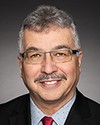Thank you, Mr. Chair.
Distinguished members of the Standing Committee on Indigenous and Northern Affairs, it's an honour and privilege to appear before you again today.
I wish to acknowledge the Algonquin Nation, upon whose traditional territory we are meeting today.
I thank you for this opportunity to share with you the work of the friendship centre movement and the National Association of Friendship Centres relative to the issues of suicide among indigenous peoples and communities.
As you may recall from my previous appearance before the committee, my name is Christopher Sheppard. I am an Inuk from northern Labrador, and I now live and work in St. John's, Newfoundland.
I grew up in the friendship centre movement. I became actively involved with the aboriginal youth council, and I am currently the vice-president of the National Association of Friendship Centres, also known as the NAFC.
Throughout my career within friendship centres, the topic and concerns of suicide have been constant, even after I left my home community in the north and moved south.
Accompanying me today is Mr. Yancy Craig, the NAFC's director of strategic development.
With our time together, I would like to give you a brief overview of the friendship centre movement, the NAFC, and the urban indigenous population of Canada. I would also like to share with you some of the programs and supports of friendship centres and the NAFC in regard to suicide prevention within urban indigenous communities. Time permitting, I will do my best to respond to the questions you may have.
I would like to begin by sharing some facts with you to set the context for the work of the friendship centre movement.
As you may know, 75% of Canada's indigenous people live off reserve. Nearly 60% live in urban areas. Furthermore the indigenous population is growing at a faster rate than the Canadian average. This means there are approximately 840,000 indigenous people living in Canadian cities.
The Canadian indigenous population is also young, with approximately 50% under the age of 24. This presents a tremendous opportunity for Canada's future social, cultural, and economic development.
Among this growing demographic, there is a growing need for mental health supports being observed. Current estimates suggest that 15% of young Canadians between the ages of 14 and 24 cope with some form of anxiety, depression, addictions, or other social distresses. Estimates among indigenous populations are twice the national average, with addictions and suicides being five to six times the national average. Friendship centres know this first-hand, and they have identified the need for additional strategies and capacity for mental health programs for urban indigenous communities, especially among youth.
As I shared with you during my previous appearance, friendship centres emerged beginning in the 1950s out of the need for indigenous people migrating to urban centres to have a friendly and welcoming space to gather and to express their culture. For over half a century, friendship centres have helped urban indigenous people access the vital services they need to succeed in urban settings across Canada. Friendship centres understand the challenges facing our communities, and with the unique wraparound service delivery model, we ensure that we are well equipped to tackle them.
Across the country, friendship centres provide culturally appropriate services for indigenous people living in urban centres, and they have become places for indigenous and non-indigenous people to come together, share traditions, and learn from one another.
Friendship centres are a significant part of Canada's social infrastructure, with more than two million client contacts annually, serving Canada's most vulnerable urban indigenous populations and making the friendship centre movement the country's most significant off-reserve indigenous service delivery infrastructure.
The NAFC was created in 1972 to be the voice of its members nationally and internationally. The NAFC's membership now comprises seven provincial and territorial associations, and 118 member friendship centres across Canada in each of your ridings.
The NAFC has a long and unique relationship with the Government of Canada. For the past 30 years, the NAFC has been the administrator of national programs delivered to friendship centres and other urban indigenous organizations on behalf of the Government of Canada.
While we are a not-for-profit network rather than a politically representative organization, the NAFC enjoys a productive relationship with many other indigenous organizations.
The effects of colonization and residential schools have led to high levels of psychological distress within indigenous communities, elders, and youth. No one is immune to those effects.
This is a concern not just for those indigenous people living on reserve, but also for those in Canada's urban centres. Statistics Canada's report “Lifetime suicidal thoughts among First Nations living off reserve, Métis and Inuit aged 26 to 59: Prevalence and associated characteristics” found that one in five off-reserve indigenous adults has contemplated suicide, and recent reports have shown that this number is continually growing. In the mental health program of one friendship centre alone, over 50% of all current clients have a risk factor for suicide.
Many indigenous people prefer cultural- and heritage-based services that are offered outside of the mainstream medical system. These often include a more holistic view of mental health and its treatments. Friendship centre programming is exactly that.
Friendship centres support culturally safe delivery of these much-needed services in innovative ways. Many centres have health outreach workers to ensure that the health needs of community members are addressed in a cultural and holistic way that addresses the physical, mental, emotional, and spiritual aspects of individuals. These services are available on a one-to-one basis or in a group setting, where action plans are developed to help meet short- and long-term goals of participants.
There are also healing and wellness programs at friendship centres, which provide support to community members seeking to access traditional services and supports, and through which action plans are also developed to help meet the goals of community members.
Friendship centres with addictions and mental health programs offer cultural spaces for individuals with mental health and addictions issues to find the help they need in moving toward a healthier lifestyle. The program also works to make better connections between urban indigenous communities and non-indigenous health services. This is done by educating non-indigenous staff about the specific needs of indigenous people and creating partnerships to connect them with a friendship centre.
Many friendship centres also have elder and youth programs providing the opportunity for open and honest discussions around the topics of healthy lifestyles, where elders share their experiences as survivors of the residential school system and information on other topics that youth may be too intimidated to ask about.
These are but a few examples of how friendship centres help heal our communities, but more needs to be done. Many of our centres do not have the funds or capacity for clinical mental health services. As we have seen with the tragic events in La Loche, Cross Lake, and too many other communities, friendship centres are heavily relied upon for their unique support programs.
The NAFC has taken on efforts to promote healing and wellness in our communities. In 2012, the NAFC's aboriginal youth council embarked on a suicide prevention and awareness project for urban aboriginal youth ages 10 to 24. This included a proposal and call-out for a suicide prevention kit, and resulted in much-needed research on indigenous youth and mental health. More recently, the NAFC launched newjourneys.ca, an online friendship centre resource. The newjourneys.ca site is home to a unique online searchable database that lists programs and services for indigenous people across the country. The site also features engaging stories, news articles, and blog posts written for the most part by indigenous youth.
As part of the development of newjourneys.ca, the NAFC has partnered with Kids Help Phone. This partnership has not only allowed the NAFC to refer indigenous children and youth to a critical emergency service, but it has also allowed Kids Help Phone to become more responsive to the unique needs of indigenous callers.
The friendship centre movement will continue to support individuals and communities, and is a willing partner in suicide prevention and mental health. The friendship centre movement and the NAFC look forward to working with the government and opposition parties to improve the lives of indigenous people in Canada. This will be achieved through core funding investments in friendship centres so that they continue to have the capacity to operate and to meet the needs of their communities, as well as to look at ways that friendship centres can expand their current successful programs that support individuals affected by suicide.
In closing, I would like to reaffirm that there are community-based solutions to complex problems like suicide. Friendship centres work every day to harness the creativity, energy, and knowledge that can unlock new ideas and new thinking that will lead to enduring social change and contribute to the healing and full inclusion of indigenous people in Canada's economic, cultural, and social fabric.
Thank you for allowing me the opportunity to speak to you today. Mr. Craig and I look forward to addressing any questions you might have.




